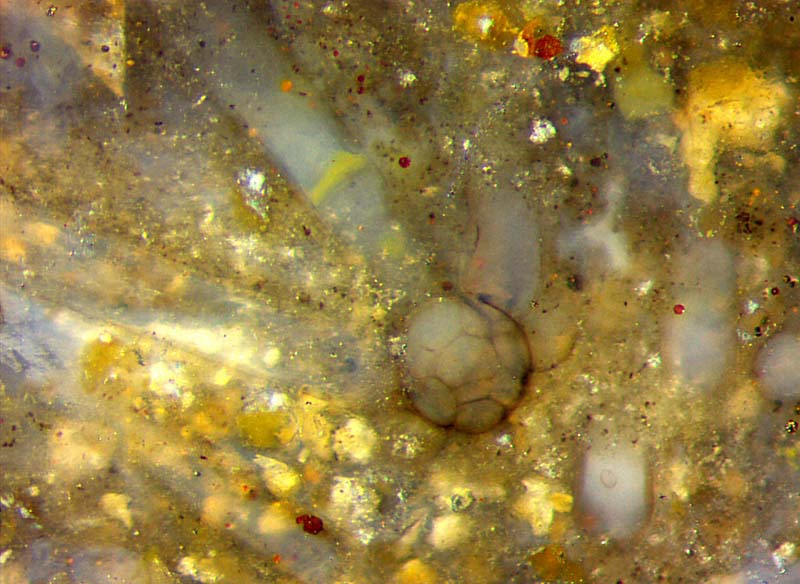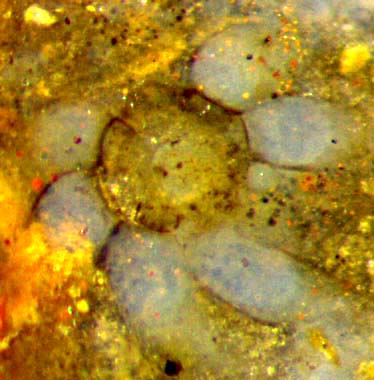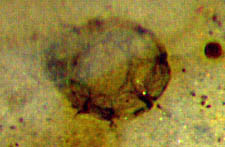A
miniature football from the Rhynie
chert
 What
looks here like a ball stitched together from polygonal patches seems
to be a solid sphere made of tightly fitting polyhedral alga cells,
placed at the base of a whorl of charophyte branches.
What
looks here like a ball stitched together from polygonal patches seems
to be a solid sphere made of tightly fitting polyhedral alga cells,
placed at the base of a whorl of charophyte branches.
The
polyhedral cells differ strongly from the big tube-like cells of the
branches. A few of the possibly 7 branches of this
whorl vanish in
the depth of the picture, hence Fig.1 is a tilted view from below. Apparently the
stem below the whorl has been cut off, thus is not seen here.
Fig.1: Multicellular sphere, 0.24mm,
at the base of a charophyte whorl with branches
consisting of big cells, seen on a cut face of
a chert sample. Image height 1mm.
Of
the charophyte algae in the Rhynie chert it is known that their stem
and branch segments consist of only one cell, like with extant Nitella, after
which the name Palaeonitella
had been coined [1]. As pointed out before [2], this might not have
been an apt choice because some or even all of the algae
called Palaeonitella are
wide apart from Nitella
and all known charophytes in a phylogenetic
sense. (See also Rhynie
Chert News 93 .)
The
ball in Fig.1 is not a unique phenomenon. There are more of such but
less beautiful ones, as in Figs.2,3 (same scale as Fig.1).

Fig.2 (left): Charophyte whorl base
exposed as a cross-section,
seen from below, on
the raw sample surface.
Image 0.65mm.
Fig.3 (below): Multicellular globule as seen just below the
raw sample surface, poorly preserved, no
branches left.
Image height 0.25mm.

Similar
as with Fig.1, the well-preserved branches of the whorl seen from below
in Fig.2 are directed upward (into the
picture plane). The segmentation of the globule is faintly indicated.
Despite of the missing branches in Fig.3, this object, too, is apparently similar to the sphere in Fig.1.
These globules differ largely from the whorl bases of Palaeonitella in [3].
All pictures have been taken from a chert sample of 0.28kg found in
2003, labelled Rh9/86.
Annotation: The interpretation of these pictures is fraught with doubt. The ball in Fig.1 is disturbingly similar to the antheridia of several recent charophytes. What is thought to be antheridia of the charophyte in this sample of Rhynie chert looks quite different. Hence, the similarity of
the sphere in Fig.1 with recent antheridia may be incidental. Another
cause of concern is the whorl bases consisting of multi-cellular
spheres, which would be a novelty among charophytes. Considering that
this charophyte is supposed to be a hitherto unnamed species, these
observations may be more interesting than disturbing.
H.-J. Weiss
2018 (emended Version)
[1] R. Kidston, W.H. Lang:
On Old Red Sandstone plants … Part V,
Trans. Roy. Soc. Edinburgh 52(1921),
855-902.
[2] H.-J.
Weiss: First
xanthophyte and new charophyte in the Rhynie chert.
87th Annual Conference of the
Paläontologische Gesellschaft, Dresden 2016.
[3] www.abdn.ac.uk/rhynie
 |
 |
129 |


 What
looks here like a ball stitched together from polygonal patches seems
to be a solid sphere made of tightly fitting polyhedral alga cells,
placed at the base of a whorl of charophyte branches.
What
looks here like a ball stitched together from polygonal patches seems
to be a solid sphere made of tightly fitting polyhedral alga cells,
placed at the base of a whorl of charophyte branches. 


